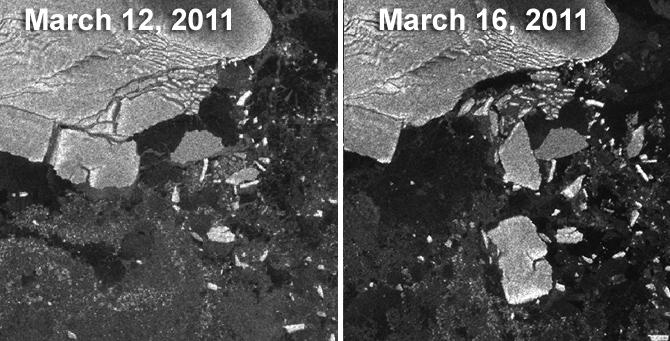Science News
Tsunami Other Damages
August 10, 2011

Two new studies point to even farther-reaching effects of the tsunami that occurred in March following a powerful earthquake in Japan.
Early this week, NASA researchers highlighted their observations of a large iceberg breaking away from Antarctica due to the powerful tsunami in the Journal of Glaciology.
Usually, scientists see icebergs break into the polar seas and work backwards to figure out the cause. But this case was different. When the tsunami started, Kelly Brunt, a cryosphere specialist at Goddard Space Flight Center, and colleagues immediately honed in on the vulnerable faces of the Antarctic continent. Using knowledge of iceberg calving and what a NOAA model showed of the tsunami’s projected path across the unobstructed Pacific and Southern oceans, the team began looking at the Sulzberger Ice Shelf, which faces Sulzberger Bay and New Zealand.
Through a fortuitous break in heavy cloud cover, Brunt spotted what appeared to be a new iceberg in MODerate Imaging Spectroradiometer (MODIS) data.
To put the dynamics of this event in perspective: An earthquake off the coast of Japan caused massive waves to explode out from its epicenter. Swells of water swarmed toward an ice shelf in Antarctica, 8,000 miles (13,600 km) away, and about 18 hours after the earthquake occurred, those waves broke off several chunks of ice that together equaled about two times the surface area of Manhattan. According to historical records, this particular piece of ice hadn't budged in at least 46 years before the tsunami came along.
And as all that was happening, scientists monitored the Antarctic ice shelves in as close to real-time as satellite imagery allows, catching a glimpse of a new iceberg floating off into the Ross Sea.
(Wired offers an amazing video of the process.)
“In the past we’ve had calving events where we’ve looked for the source. It’s a reverse scenario—we see a calving and we go looking for a source,” Brunt said. “We knew right away this was one of the biggest events in recent history—we knew there would be enough swell. And this time we had a source.”
A far more subtle effect showed up miles above Earth! National Geographic Daily News covered a study last week in the Journal of Geophysical Research that describes how the tsunami waves produced vibrations that rose into the atmosphere, growing larger the higher they went.
At heights where airplanes travel, about 30,000 feet (9,100 meters), [Emile] Okal said, the waves from the Japan disaster might have expanded to about three feet (one meter) in amplitude, which is the extent at which a vibration travels from its normal state of equilibrium. That’s not enough for an air passenger to even feel a bump.
But in the upper atmosphere, the ionosphere, the waves were amplified to thousands of times their original sizes, scientists say.
Seismic waves in earth, water, and air—the events in Japan affected our world in more ways than one.
Image: European Space Agency/Envisat